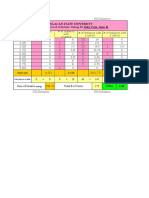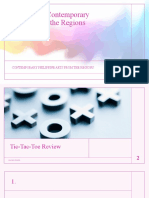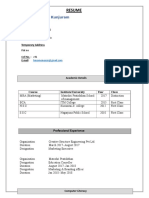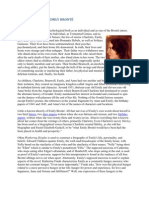Science High
Science High
Uploaded by
Donna Sheena SaberdoCopyright:
Available Formats
Science High
Science High
Uploaded by
Donna Sheena SaberdoOriginal Description:
Copyright
Available Formats
Share this document
Did you find this document useful?
Is this content inappropriate?
Copyright:
Available Formats
Science High
Science High
Uploaded by
Donna Sheena SaberdoCopyright:
Available Formats
Fast Fact about Science High School
1. PSHS is the brainchild of a Filipino mathematician
2. Republic Act No. 3661 established PSHS
3. PSHS started out in a rented building owned by the Philippine Government
Employees Association (PGEA)
4. Admission in PSHS is competitive
5. Sciences and Mathematics courses make up the core curriculum of PSHS
6. PSHS students are expected by law to take a science/math college course upon
entering college
7. PSHS has 13 campuses in the Philippines
8. Republic Act No. 8496 established the PSHS System
9. PSHS has produced notable scientists, academicians, and journalists
Some of the notable PSHS alumni are:
Adolfo Jesus Gopez - president of FEATI University
Reynaldo B. Vea - president of the Mapua Institute of Technology
Joseph Emilio "Jun" Aguinaldo Abaya - current DOTC Secretary
Jessica Zafra - writer and collumnist
Rowena Guevara - first woman Dean of the UP College of Engineering
Atom Araullo - ABS-CBN journalist and newscaster
Luis Katigbak - a multi Palanca awardee writer
Jose Dalisay Jr. - editor, book author, and multi-Palanca awardee writer
Miriam Coronel-Ferrer - UP Professor and head of the government peace panel
during the negotiations that led to the signing of the Bangsamoro Basic Law
10. An internationally-acclaimed movie about PSHS has been produced
Implementation of the 2002 Basic Education Curriculum
It is the product of 16 years of study conducted under the various DepEd
secretaries (Lourdes Quisumbing, Isidro Cario, and Bro. Andrew Gonzalez). Starting
1995, intensive consultations were held with various stakeholders the schools,
DONNA SHEENA M. SABERDO 1
EDUCATION CURRICULUM
parents, students, business, trade and industry, NGOs and the people in the Education
Department who administer the education system on ground level.
According to Sec. of Education Raul Roco, the 2002 BEC was based on a 16-
year study (starting in 1986).
Implementation of RBEC was based on Executive Order No. 46, which in turn
was based on the recommendations of the Philippine Commission on
Educational Reforms (PCER), created on Dec. 7, 1998.
The restricting of the curriculum is part of an ongoing effort to improve the
quality of learning. We are focusing on the basics of improving literacy and
numeracy while inculcating values across learning areas to make it dynamic.
(Raul Roco)
The 2002 BEC is a restricting and not a sweeping change of the elementary
and secondary curricula (NESC & NSEC)
The implementation of the 2002 Basic Education Curriculum was announced in
DepEd Order No. 25, s. 2002, issued on June 17, 2002.
The actual implementing guidelines were found in DepEd Order No. 43, s.
2002, dated Aug. 29, 2002.
Less than a year later (on June 12, 2002), a new curriculum (the Revised BEC)
was signed into law.
Revised Basic Education Curriculum
(RBEC 2002-2010)
The objectives of elementary and secondary education serve as the official
learning goals of basic education as stated for a particular population of
learners; that is, the elementary and secondary education learners.
The Bureau of Alternative Learning System (formerly Non-formal Education)
likewise has a set of official learning goals for its particular set of target learners
the out-of-school youth and adults.
The Education Act of 1982 or Batas Pambansa Blg. 232 provides the general
objectives of elementary, secondary, and non-formal education.
DONNA SHEENA M. SABERDO 2
EDUCATION CURRICULUM
The objectives of elementary education are as follows:
1. Provide the knowledge and develop the skills, attitudes, and values essential
for personal development, a productive life, and constructive engagement with
a changing social milieu;
2. Provide learning experiences that increase the childs awareness of and
responsiveness to the just demands of society;
3. Promote and intensify awareness of, identification with, and love for our
nation and the community to which the learner belongs;
4. Promote experiences that develop the learners orientation to the world of
work and prepare the learner to engage in honest and gainful work.
The objectives of secondary education are threefold:
Continue the general education started in elementary.
Prepare the learners for college.
Prepare the learners for the world of work.
Curriculum Structure of 2002 BEC/ RBEC
The Core Subjects:
Filipino
English
Math
Science (Science and Health for Elementary);
(Science and Technology for Secondary)
The Experiential Area:
Makabayan: Araling Panlipunan
MAPEH (Music, Arts, PE, and Health)
TLE
Edukasyon sa Pagpapahalaga (the practice for environment for holistic learning
to develop a healthy personal and national self-identity)
DONNA SHEENA M. SABERDO 3
EDUCATION CURRICULUM
You might also like
- Roles and Responsibilities of Class Officers PDFDocument3 pagesRoles and Responsibilities of Class Officers PDFEl ProfessorNo ratings yet
- Exploring Filipinos' Little Languages in The 21st Century Final PaperDocument6 pagesExploring Filipinos' Little Languages in The 21st Century Final PaperMalvin Ramos100% (1)
- Views and Experiences of Some Manobo On Philsaga Mining (Socio Cultural Change On Views On Mining!! Focus On Philsaga!!)Document89 pagesViews and Experiences of Some Manobo On Philsaga Mining (Socio Cultural Change On Views On Mining!! Focus On Philsaga!!)JanJan ClarosNo ratings yet
- MATATAG-Lesson Exemplar-ENGLISHDocument2 pagesMATATAG-Lesson Exemplar-ENGLISHgradeonefiles2023No ratings yet
- CFS Action Plan 2020-2021Document1 pageCFS Action Plan 2020-2021Kim MoritNo ratings yet
- History - Department of EducationDocument7 pagesHistory - Department of Educationelberth castorNo ratings yet
- Bulacan State University: Office of The Dean of InstructionDocument8 pagesBulacan State University: Office of The Dean of InstructionMarjorie San GabrielNo ratings yet
- History of BatanesDocument5 pagesHistory of BatanesELSA ARBRENo ratings yet
- 31 Lspu Acad - Title Defense FormDocument1 page31 Lspu Acad - Title Defense FormhyaNo ratings yet
- Lesson 3:: Kicking It OffDocument3 pagesLesson 3:: Kicking It OffKevin BlasurcaNo ratings yet
- CHAPTER 2 - CD Modes Acquisition of School SitesDocument37 pagesCHAPTER 2 - CD Modes Acquisition of School SitesPrecious Marga BaldeoNo ratings yet
- Osmeña Family: By: NatashaDocument12 pagesOsmeña Family: By: NatashaNatasha SyNo ratings yet
- Annex B Membership Application FormDocument4 pagesAnnex B Membership Application FormJohn Cedrick JagapeNo ratings yet
- LESSON 10 FOUNDATIONS and CORE VALUES of DEV COMDocument12 pagesLESSON 10 FOUNDATIONS and CORE VALUES of DEV COMPAGDATO, Ma. Luisa R. - 1FMBNo ratings yet
- Republic Act No 2067Document6 pagesRepublic Act No 2067Seph UltimaNo ratings yet
- Teaching Science in The PhilippinesDocument5 pagesTeaching Science in The PhilippinesCarisse Angeli CruzNo ratings yet
- CHED Full Blown Proposal RPAG Form TEMPLATE Sep.2021Document14 pagesCHED Full Blown Proposal RPAG Form TEMPLATE Sep.2021Dix TyNo ratings yet
- TPC Student Handbook For August 22 2023 OrientationDocument52 pagesTPC Student Handbook For August 22 2023 OrientationraiyaekNo ratings yet
- Bda 604 Business Management SyllabusDocument7 pagesBda 604 Business Management SyllabusDaisy ObisoNo ratings yet
- Species Distribution and Relative Abundace of Land Snails in Mt. MusuanMaramag Bukidnon.Document14 pagesSpecies Distribution and Relative Abundace of Land Snails in Mt. MusuanMaramag Bukidnon.Fatimae Delos SantosNo ratings yet
- Music in Mindanao Indigenous PracticesDocument2 pagesMusic in Mindanao Indigenous PracticesJM TermuloNo ratings yet
- Cagayan Dances Dance Literature GAKKADocument5 pagesCagayan Dances Dance Literature GAKKAsandy d amor c. rosalesNo ratings yet
- Data Structure and Algorithms Sylabus Sta RitaDocument15 pagesData Structure and Algorithms Sylabus Sta RitaBrittaney BatoNo ratings yet
- Covenant ManagementDocument6 pagesCovenant Managementapi-3004722920% (1)
- DOCUMENT REVIEW ON DEPED ORDER NO. 30 S. 2019Document1 pageDOCUMENT REVIEW ON DEPED ORDER NO. 30 S. 2019Arjielyn Orzal GantalaNo ratings yet
- 10 Fun Facts About The History of The MicroscopeDocument2 pages10 Fun Facts About The History of The MicroscopejasenkoĐ0% (1)
- BSP - FITT 3 - Physical Activity Towards Health and Fitness Sacopanio PDFDocument15 pagesBSP - FITT 3 - Physical Activity Towards Health and Fitness Sacopanio PDFJayjay SacopanioNo ratings yet
- NSTP Worksheet Number 4Document5 pagesNSTP Worksheet Number 4FRANCISCO, CRISLYN JUMARITO.No ratings yet
- Module 2 Philippine Geography New VersionDocument2 pagesModule 2 Philippine Geography New VersionVillasencio Paul ChristopherNo ratings yet
- Educational Resource Planning and ManagementDocument1 pageEducational Resource Planning and ManagementQuel Evangelista100% (1)
- CNHS SHS Enrollment Form 2019Document2 pagesCNHS SHS Enrollment Form 2019Arthur Capawing100% (8)
- A Reflection About Renato Constantino's The Miseducation of The Filipino and Its Relevance in The Present Day PhilippinesDocument4 pagesA Reflection About Renato Constantino's The Miseducation of The Filipino and Its Relevance in The Present Day PhilippinesborlagdanleematthewNo ratings yet
- Yen2 Science ProjectDocument39 pagesYen2 Science ProjectPalang AcedimNo ratings yet
- Department of Education: Republic of The PhilippinesDocument3 pagesDepartment of Education: Republic of The PhilippinesYuri DunlaoNo ratings yet
- Essay On Flexible LearningDocument4 pagesEssay On Flexible LearningNathan Atkins0% (1)
- 2013 FLEMMS Final ReportDocument150 pages2013 FLEMMS Final ReportReynald RamirezNo ratings yet
- Summary of Michael Carlo Villas' Introduction To The Siday (2015)Document9 pagesSummary of Michael Carlo Villas' Introduction To The Siday (2015)Joshua PerezNo ratings yet
- KonKom 113 Course Syllabus 1Document9 pagesKonKom 113 Course Syllabus 1Lainne ReyesNo ratings yet
- History of La UnionDocument8 pagesHistory of La UnionELSA ARBRENo ratings yet
- Manny PacquiaoDocument2 pagesManny PacquiaoRyan RayoNo ratings yet
- The Effect To The Academic Performance of Senior High Students Due To Covid-19 PandemicDocument6 pagesThe Effect To The Academic Performance of Senior High Students Due To Covid-19 PandemicFrankyl Paz0% (1)
- Tagisan NG Talino at Galing 2012Document4 pagesTagisan NG Talino at Galing 2012Jovenil BacatanNo ratings yet
- Philippines Debate Use of Filipino As Instruction MediumDocument5 pagesPhilippines Debate Use of Filipino As Instruction MediumBern Calugcug de GuzmanNo ratings yet
- Major in English Room AssignmentDocument34 pagesMajor in English Room AssignmentPRC BaguioNo ratings yet
- GWA TemplateDocument2 pagesGWA TemplateMari CrisNo ratings yet
- MODULE 6 COMMUNICATION FOR VARIOUS PURPOSES Part 2Document9 pagesMODULE 6 COMMUNICATION FOR VARIOUS PURPOSES Part 2Ashley Judd Mallonga BeranNo ratings yet
- UDM Student ManualDocument122 pagesUDM Student Manualje2520258No ratings yet
- Supreme Student Government Action Plan SY 2016-2017Document2 pagesSupreme Student Government Action Plan SY 2016-2017DanielNacorda100% (1)
- Lived Experiences of The Senior High School TeachersDocument11 pagesLived Experiences of The Senior High School Teachers사랑태극No ratings yet
- Organizational Constitution and BylawsDocument25 pagesOrganizational Constitution and BylawsMatt VisualsNo ratings yet
- Criteria For Chamber Theater (Gas 12)Document4 pagesCriteria For Chamber Theater (Gas 12)Dante Jr. BitoonNo ratings yet
- Definition of TermsDocument12 pagesDefinition of TermsNiña Damalerio MongeNo ratings yet
- Philippine Presidents and Their Contributions To ScienceDocument12 pagesPhilippine Presidents and Their Contributions To ScienceJaypee CarlNo ratings yet
- STS 1 - Module 1 ReviewerDocument37 pagesSTS 1 - Module 1 ReviewerPatrick Angelo Abalos Soriano100% (1)
- A Narrative Report On The Reading Month CelebrationDocument21 pagesA Narrative Report On The Reading Month CelebrationmecijajenNo ratings yet
- Amplifying Teaching and Student Engagement With Educational Technology and ToolsDocument5 pagesAmplifying Teaching and Student Engagement With Educational Technology and Toolsvexyl caneteNo ratings yet
- PINPEATDocument10 pagesPINPEATJunex SilaganNo ratings yet
- SYLLABUS (Science, Technology & Society With HIV AIDS EDUC.)Document4 pagesSYLLABUS (Science, Technology & Society With HIV AIDS EDUC.)Lemmuel PajaronNo ratings yet
- Bec 2002 - RbecDocument4 pagesBec 2002 - RbecNiña Romina G. NavaltaNo ratings yet
- Education System in The Recent YearsDocument9 pagesEducation System in The Recent Yearslizbet08No ratings yet
- Narrative Catch Up Friday Grade 2Document2 pagesNarrative Catch Up Friday Grade 2Donna Sheena Saberdo100% (2)
- Drop Off and Pick Up ProceduresDocument3 pagesDrop Off and Pick Up ProceduresDonna Sheena SaberdoNo ratings yet
- Republic of The PhilippinesDocument7 pagesRepublic of The PhilippinesDonna Sheena SaberdoNo ratings yet
- Monte de Tanay Elementary School Action Plan in Conducting Limited Face To Face LearningDocument7 pagesMonte de Tanay Elementary School Action Plan in Conducting Limited Face To Face LearningDonna Sheena SaberdoNo ratings yet
- Inspection and Acceptance ProtocolDocument16 pagesInspection and Acceptance ProtocolDonna Sheena SaberdoNo ratings yet
- Dance CriteriaDocument1 pageDance CriteriaDonna Sheena SaberdoNo ratings yet
- Faultline QuestionaireDocument3 pagesFaultline QuestionaireDonna Sheena SaberdoNo ratings yet
- DLL WEEK2Document21 pagesDLL WEEK2Donna Sheena SaberdoNo ratings yet
- Physical Education 6 Maglalatik or Magbabao DanceDocument1 pagePhysical Education 6 Maglalatik or Magbabao DanceDonna Sheena SaberdoNo ratings yet
- Camp Mateo Capinpin Elementary School: Weekly Home Learning PlanDocument7 pagesCamp Mateo Capinpin Elementary School: Weekly Home Learning PlanDonna Sheena SaberdoNo ratings yet
- Camp Mateo Capinpin Elementary School: Learning Activity SheetDocument3 pagesCamp Mateo Capinpin Elementary School: Learning Activity SheetDonna Sheena SaberdoNo ratings yet
- Department of Education: Teacher: Mrs. Rosalinda M. de Guzman Principal: Mrs. Menerva G. CustodioDocument3 pagesDepartment of Education: Teacher: Mrs. Rosalinda M. de Guzman Principal: Mrs. Menerva G. CustodioDonna Sheena Saberdo100% (3)
- Camp Mateo Capinpin Elementary School: English 6 Learning Activity SheetsDocument4 pagesCamp Mateo Capinpin Elementary School: English 6 Learning Activity SheetsDonna Sheena SaberdoNo ratings yet
- ICT LAC Activity Cards TemplateDocument22 pagesICT LAC Activity Cards TemplateDonna Sheena Saberdo100% (1)
- Project Title EsipDocument21 pagesProject Title EsipDonna Sheena SaberdoNo ratings yet
- Camp Mateo Capinpin Elementary School: Department of EducationDocument6 pagesCamp Mateo Capinpin Elementary School: Department of EducationDonna Sheena SaberdoNo ratings yet
- Certificate of Recognition: Juan Dela CruzDocument6 pagesCertificate of Recognition: Juan Dela CruzDonna Sheena SaberdoNo ratings yet
- Year End Canteen 2014 2015 Mdes 1Document18 pagesYear End Canteen 2014 2015 Mdes 1Donna Sheena SaberdoNo ratings yet
- Certification 5Document1 pageCertification 5Donna Sheena SaberdoNo ratings yet
- Kinder Lesson Plan Week 3Document1 pageKinder Lesson Plan Week 3Donna Sheena SaberdoNo ratings yet
- Class Program 2017-2018Document6 pagesClass Program 2017-2018Donna Sheena SaberdoNo ratings yet
- Huamn Growth and DevelopmentDocument12 pagesHuamn Growth and DevelopmentDonna Sheena Saberdo100% (1)
- Alphabet Stories WordDocument26 pagesAlphabet Stories WordDonna Sheena Saberdo67% (3)
- Name: DATE: - Teacher: Donna Sheena M. Saberdo ScoreDocument5 pagesName: DATE: - Teacher: Donna Sheena M. Saberdo ScoreDonna Sheena SaberdoNo ratings yet
- AnimalsDocument3 pagesAnimalsDonna Sheena SaberdoNo ratings yet
- MultilingualDocument52 pagesMultilingualAngel Jasmine LlevaNo ratings yet
- ECL Writing Guide Essay B2Document2 pagesECL Writing Guide Essay B2Zsófia MakraNo ratings yet
- Borobudur Temple Compounds: World's Cultural HeritageDocument33 pagesBorobudur Temple Compounds: World's Cultural HeritageAppzNo ratings yet
- Exam ScheduleDocument2 pagesExam ScheduleTopRankersNo ratings yet
- E - Learning Agreement TraineeshipsDocument4 pagesE - Learning Agreement TraineeshipsBagas Putra PratamaNo ratings yet
- Cpar Week 3 - 2022Document36 pagesCpar Week 3 - 2022Sid BoniteNo ratings yet
- Resume: Nair Bavamone KunjuramDocument4 pagesResume: Nair Bavamone KunjuramImranNo ratings yet
- IntroDrama Types FormsDocument44 pagesIntroDrama Types FormsalalaLarusshhNo ratings yet
- York Report FinalOct2010Document32 pagesYork Report FinalOct2010mohd azriNo ratings yet
- Summer 2010Document1 pageSummer 2010warhorsepaoNo ratings yet
- What Are The Types of Reading in EnglishDocument1 pageWhat Are The Types of Reading in EnglishMelody Aurelio SinenteNo ratings yet
- The Magical Character of The Summer SolsticeDocument3 pagesThe Magical Character of The Summer SolsticeKat Sugar100% (1)
- Assignment UCS 102 - SEPT2019Document6 pagesAssignment UCS 102 - SEPT2019edelzNo ratings yet
- Farewells and ResponsesDocument18 pagesFarewells and ResponsesORANCELI MORENO DEGANUTI CARBALLONo ratings yet
- The Use of Speaking Pal Application in Teaching EFL Students in Developing Speaking SkillsDocument8 pagesThe Use of Speaking Pal Application in Teaching EFL Students in Developing Speaking Skillsues athoillah100% (2)
- Hands-On Conf 2006 PDFDocument707 pagesHands-On Conf 2006 PDFMiguel Sette E CamaraNo ratings yet
- Pre Invite - Cnlu Legal Aid FestDocument7 pagesPre Invite - Cnlu Legal Aid FestRajeshwari IshuNo ratings yet
- Overview of Emily BrontëDocument24 pagesOverview of Emily BrontëNarendraNo ratings yet
- Drescoll and Mckee, 2007Document13 pagesDrescoll and Mckee, 2007Abdul SamiNo ratings yet
- Civil Political Rights PDFDocument4 pagesCivil Political Rights PDFAnonymous dLIq7U3DKzNo ratings yet
- To The Lighthouse To The SelfDocument36 pagesTo The Lighthouse To The SelfSubham GuptaNo ratings yet
- Thesis For ScribdDocument111 pagesThesis For Scribdanne100% (4)
- Catholic Church Teaching On MarriageDocument4 pagesCatholic Church Teaching On MarriageVick BatlyolNo ratings yet
- Leadership Dev Comp Guide 2-FINAL-Jan31-2019Document28 pagesLeadership Dev Comp Guide 2-FINAL-Jan31-2019Philip DanNo ratings yet
- Introduction and Its BackgroundDocument18 pagesIntroduction and Its BackgroundAriane MalloNo ratings yet
- What Are Universities For Geoffrey Boulton FRS Sir Colin LucasDocument19 pagesWhat Are Universities For Geoffrey Boulton FRS Sir Colin LucaspapintoNo ratings yet
- LP g4 Sip Weeks 1-6Document21 pagesLP g4 Sip Weeks 1-6Glynis VillamilNo ratings yet
- Civil Society4Document9 pagesCivil Society4bimaNo ratings yet
- Ntrance XAM Arch: Instituto de Enseñanza Superior en Lenguas Vivas "J. R. Fernández"Document7 pagesNtrance XAM Arch: Instituto de Enseñanza Superior en Lenguas Vivas "J. R. Fernández"Valentina PolicaroNo ratings yet

















































































































